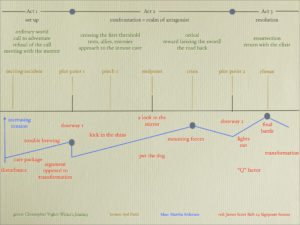I love revision. My first drafts tend to be real ugly ducklings. If there’s a swan inside, it only emerges after multiple revisions.
In this post, I’m giving you two things: first, my ten-point global revision technique; and second, my detail checklist. The detail checklist is especially helpful for getting rid of those pesky errors introduced through laziness. I hope these help!
Ten-point revision checklist:
- Reread entire manuscript in one sitting, making margin notes and keeping track of details (i.e., character eye color, dates, place names) for consistency.
- Confirm that tone, POV, and voice are working.
- Identify large-scale plot weaknesses. Use Martha Alderson, aka, The Plot Whisperer or James Scott Bell’s Write Your Novel From the Middle to locate plot turning points and confirm that tension is increasing appropriately.
- Make a scene or chapter chart, as per Martha Alderson or Darcy Pattison (Novel Metamorphosis).
- Try Pattison’s “shrunken manuscript” technique.
- Identify your characters’ arcs. Make sure you have a “story-worthy problem” (the true underlying problem your character must resolve – see HOOKED by Les Edgerton) and a resonant theme. Make sure that the story-worthy problem is discovered by both reader and protagonist late in the story, ideally around the climax.
- Use Cheryl Klein’s plot checklist worksheet to further clarify theme and emotional arcs.
- Rewrite/type entire manuscript from a hard copy. Read entire manuscript out loud.
- Use a checklist for minor issues or run through Darcy Pattison’s exercises.
- Do exercises in Donald Maass’s Writing the Breakout Novel Workbook.
Detail revision checklist:
In addition to smoothing all those plot inconsistencies, adding twists and turns, and working on character-deepening, there are a few things I “checklist” as I revise.
- Find all the “ly” words (i.e., adverbs) by using the Word search feature and eliminating most.
- Search for “it is/was” and “there is/was”. It’s almost always stronger to use different phrasing. (Or…Phrases are almost always stronger without “it’s”.)
- Search for places where my character “felt,” “thought,” “saw,” “looked,” “noticed,” “remembered,” etc. When I’m really inside my character, those phrases aren’t necessary.
- Search for sentence “flow.” In particular, I look sentence by sentence for stronger first and last words.
- Search for passive voice and other indicators of “telling.”
- Try to make sure there’s tension on every page.
- Remove dialogue tags wherever possible. Even “said” can get in the way when only two people are talking.
- Make sure gesture substitutes for internal thoughts wherever possible.
- Look for those things that popped up in my subconscious and may be amplified – recurring metaphors or images.
- Watch for repetition.
- “Voice” – either jargon, dialect, or manner of speaking as appropriate
- Remove “just” “so” or other personal hiccups
- Remove linking verbs
- Remove “then,” “when”
- Add physical gestures/personal tics
- Check five senses
If you have any revision checklist ideas to add, please do!


Janet, All your writing posts are so clear and helpful! And just what I need when I need it! Thank you!! Randle
Aw, thanks Randle!! So happy I can help!
Nice Janet!
Thanks, Kari! Hugs!!
Janet, this is a terrific gathering of the best of the best. The only thing on my “wish list” is a checklist, or thesaurus or “gathering place” for gestures. “Gasped, nodded, shrugged, winked, stiffened …” Have you come across a resource? Many thanks for your generous post. Maggie Moris
Maggie, there is a resource! It’s THE EMOTION THESAURUS here’s the link: http://writershelpingwriters.net/the-emotion-thesaurus-a-writers-guide-to-character-expression/ I hope this helps!!
Fabulous! Thank you, Janet. Too often I “throw my hands up in the air” with frustration when I describe the same gestures over and over. Snort. You’re a peach.
Great post, Janet. You have brought together a lot of resources here. Would you be interested in sharing this on my website? This information is of great value to authors everywhere. I average well over 300 unique visitors daily to my website. You would get all the credit for the post. You have my email.